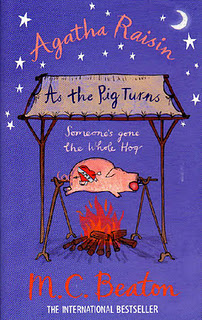Years ago, my mother-in-law sent me the first three of four books of a series I have come to really enjoy: the Agatha Raisin series by M.C. Beaton.
There is an
official website for all things Agatha, and other series by the same author. Now, if you are looking for the most elaborate plots, the most descriptive landscape scenes, the most atmospheric places and high-brow literature, you will be disappointed.
But if you are looking for fast-paced, entertaining and sometimes rather comical "Cosy Mysteries", then I think you will like Agatha Raisin.
"As the Pig Turns" is the latest in the series, and if there is one thing I don't like about these books is that I finish them so quickly.
Things really do happen fast, and sometimes M.C. Beaton (real name Marion Chesney) skips through several months in one brief paragraph. Still, the recurring cast of characters is, in the course of the series, portrayed deeply enough to make you think you "know" those people, and can get a rather clear image in your mind of what they look and speak and move like.
This time, a murder is committed in the nearby Cotswolds village of Winter Parva (it does not really exist, just as Agatha's chosen home village of Carsely does not exist, but the way these villages are described, you can tell they are modeled on real life). The dead body is displayed in the most gruesome fashion, and turns out to be that of a policeman generally hated by everyone - but hated enough to be murdered?
Agatha is set to find out, and in the course of her investigation, unlike in most of the other parts of the series, she herself is never really in danger, but several of her friends and staff at her detective agency are almost killed.
Agatha is famous for always needing a man she can be obsessed about in her life. Her ex-husband makes an appearance, as does her ex-(? really?)lover Charles (I still think she should set up shop with him for good; he is my favourite male character in the series and I know exactly what he looks and speaks like). In the last chapter of the book, though, we witness the start of something new - the author clearly leaves room here for the next instalment, which I am already looking forward to.
Let me give you a few examples of typical Agatha-Raisin-style bits:
While Agatha and her ex-husband James (he had helped her in the past with her investigations) have a meal at a restaurant together, they discuss the latest developments in the case:
"Did Gary Beech leave a will?" asked James.
"Yes. He left everything to Amy." She pulled out her mobile and dialled Patrick [an employee at her detective agency]. When she rang off, she said: "No further news. There are the diamonds, of course. That's probably what they were looking for. Maybe Amy put the house up for sale. The police have surely finished with it."
"Let's just enjoy our dinner, go home and change, and then we'll break in."
Agatha grinned happily. "Quite like old times."
A short but nice description of Agatha's surroundings:
Agatha could almost smell the countryside coming to life after the bitter winter. The sky above was pale blue, and somewhere nearby a blackbird poured down its song.
It was on mornings like this that Agatha realized why she loved living in the Cotswolds so much. Perhaps, she thought, there is nowhere more beautiful in Britain than this man-made piece of England with its thatched cottages and gardens crammed with flowers.
At a banquet held to honour the "Woman of the Year", the "host" is described in a way I can really see and hear him:
Guy Brandon took the microphone. [He] was wearing a pale blue sweater over a striped shirt and very tight jeans.
He began to 'amuse'. He twittered, he clowned, he laughed hilariously at his own jokes, and in all, thought Agatha, he bored for Britain.
One of Agatha's employees, 18-year-old Toni, features quite a lot in this book. She has a rather different life from that of many other 18-year-olds, taking her work seriously:
She often felt quite lonely in the evenings these days. Her old school friends seemed like strangers. She felt she had moved on out of their world: a world of discos and binge drinking and dreaming of becoming celebrities without getting any skills such as acting, singing or dancing.
While I fear this really is true for many teenagers (not only in Britain), I know there are still some Toni-like, responsible and level-headed girls and boys out there; one of them being, for instance, my niece Beth - she takes school seriously, works at a book shop in her spare time and still does not forget to have fun. Last month, she turned 18; next year, she is going to start at Liverpool Uni (if all goes well), to study Egyptology.
Well, this was not intended to be about my family, but simply the book review of my latest read.
And now, I am turning to non-fiction again.


















































